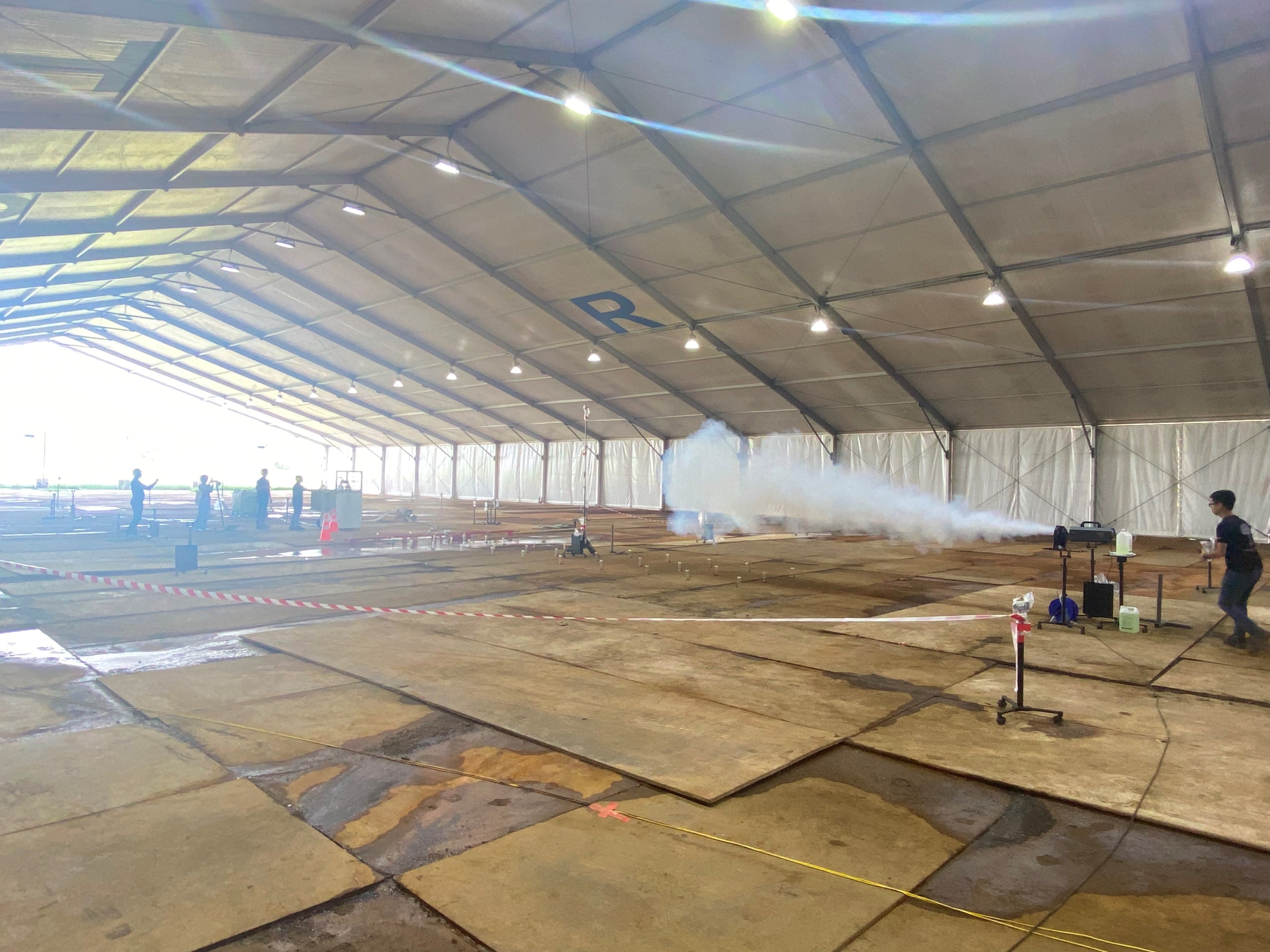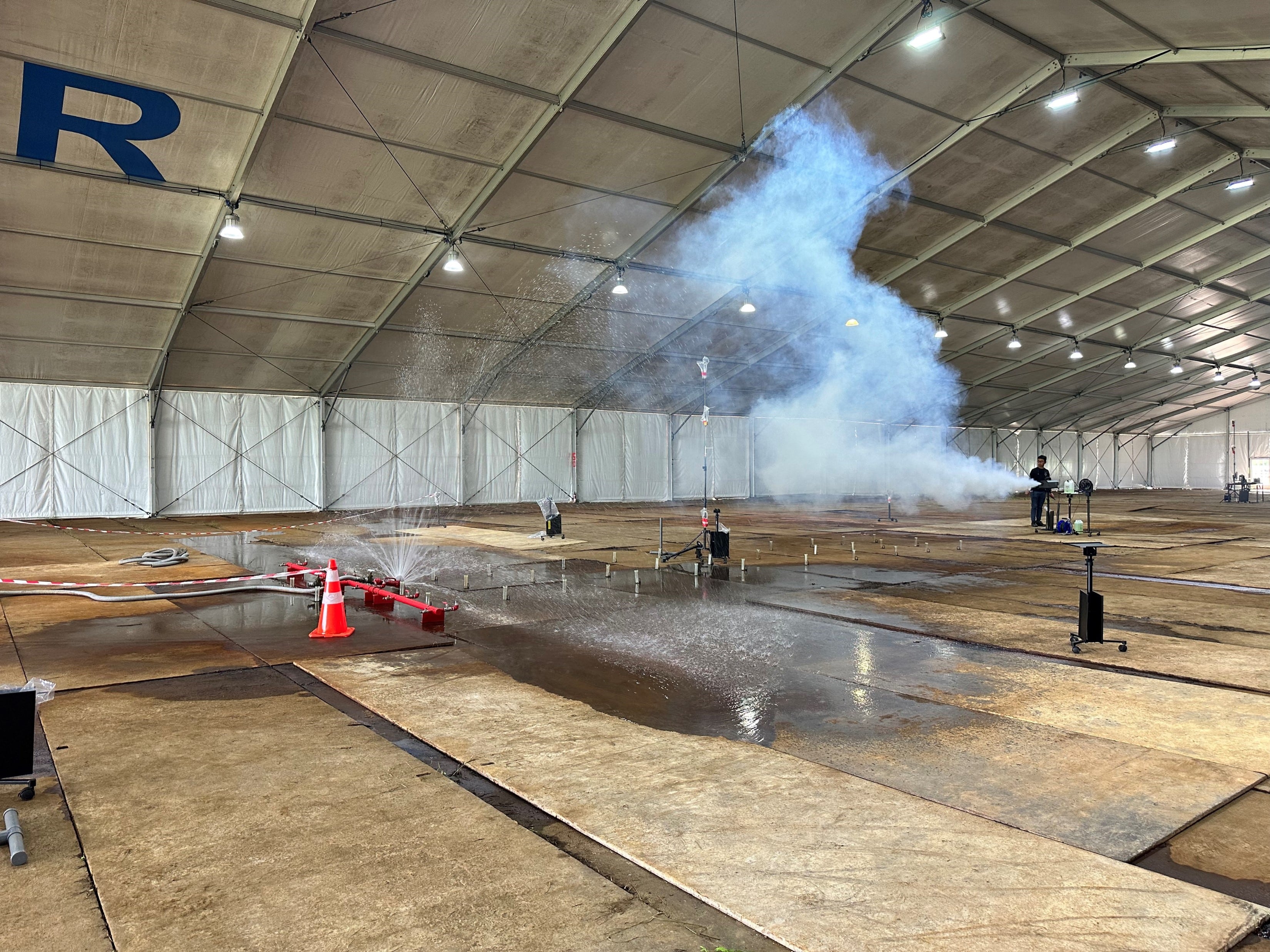HTX recently conducted a trial to assess the effectiveness of countermeasures to purge toxic clouds from the atmosphere.

The project team with HTX Deputy Chief Executive (Development) Ng Yeow Boon, HTX Senior Scientific Consultant Dr Lee Fook Kay, CBRNE CoE Director May Ong, and Associate Professor An Hui from the Engineering Cluster of the Singapore Institute of Technology. (Photo: HTX)
An industrial accident occurs in a factory that stores toxic chemicals. When these deadly chemicals explode from their ruptured containers, people are killed or severely injured in the immediate vicinity. The deadly vapours float into the atmosphere and become a cloud of poisonous gas. Unknown to those who could soon be affected, the winds blow the toxic cloud towards the nearby housing estates...
This nightmare scenario is not mere science fiction. Toxic chemicals are stored and used in Singapore’s industrial estates, and industrial accidents can and do occur. The scientists and engineers of HTX’s Chemical, Biological, Radiological, Nuclear, and Explosives (CBRNE) Centre of Expertise (CoE) have been working hard to develop ways to detect and disperse these toxic clouds should they occur. But even if we could detect such clouds of poisonous gas and predict where they are headed, what can be done to safely purge or dilute these toxic clouds from the atmosphere before they reach human habitation?

Releasing smoke at the CBRNE Kranji test site for visual checking before actual tracer gas testing. (Photo: HTX)
As it turns out, CBRNE CoE has assessed several countermeasures to purge these toxic clouds from the atmosphere, and their scientists and engineers recently set up a trial at an isolated 6,000 square metre site in Kranji to evaluate the effectiveness of these different countermeasures – both as standalone methods and in combination with one another.
These countermeasures – including water curtains, turbo jets, water jets, and turbo hydro jets – had previously been assessed through Computational Fluid Dynamics (CFD) simulations, and the trial sought to validate the simulation results.

Monitoring the gas dispersion and studying the effectiveness of dispersing the plumes with a turbo hydro jet release. (Photo: HTX)
The project team replicated the countermeasures used by the Singapore Civil Defence Force (SCDF) but scaled them down for the experiments. The other equipment for the trial included a standoff gas release mechanism and a fan wall to generate wind speed and flow of approximately 2m/s; a suite of sensors including a network of webcams and gas detectors, anemometers (devices to measure wind speed and wind pressure), gas analysers, and a grid of rain gauges. The scaled countermeasures and detection equipment were all remotely controlled and monitored during tracer gas release experiments.
In total, the project team collected huge amount of test data from 35 sets of day and night experiments. With these results, the team is working hard to construct an experimental database that will be useful for years to come.

Visualising the barrier effect of a water curtain using smoke. (Photo: HTX)
Dr Ma Yifei, the project team leader who also serves as the Deputy Director for Threat Simulation and Mitigation at CBRNE CoE, explained that the results that were collected from the experiments will be used to develop computational and experimental methods to assess the effectiveness of the mitigation measures against chemical plumes. These methods can also be used to evaluate and develop advanced chemical detection capabilities, for example, detecting chemicals with unmanned systems.
Ultimately, the data from these studies will guide the SCDF to deploy the most effective countermeasures to deal with wide area chemical threats. As COL Shaiful Herman Shali, the Director of the SCDF’s HazMat Department, shared: “The trial was planned and executed well by our HTX counterparts. The analysis will certainly help SCDF to determine what type of mitigation measures can be used, and in what combination, for the most effective outcomes.”
HTX’s partners for the project include the Singapore Institute of Technology, which shared its expertise on wind tunnel operations and dispersion modelling and participated in the development and validation of the CFD simulation platform; and the National University of Singapore, which consulted on the trial setup. The project started in 2021 and is expected to be completed in 2025, with operational deployment in 2026.
This project was recently showcased at the Milipol Asia-Pacific – TechX Summit exhibition held at the Marina Bay Sands convention centre from 3-5 April 2024.

